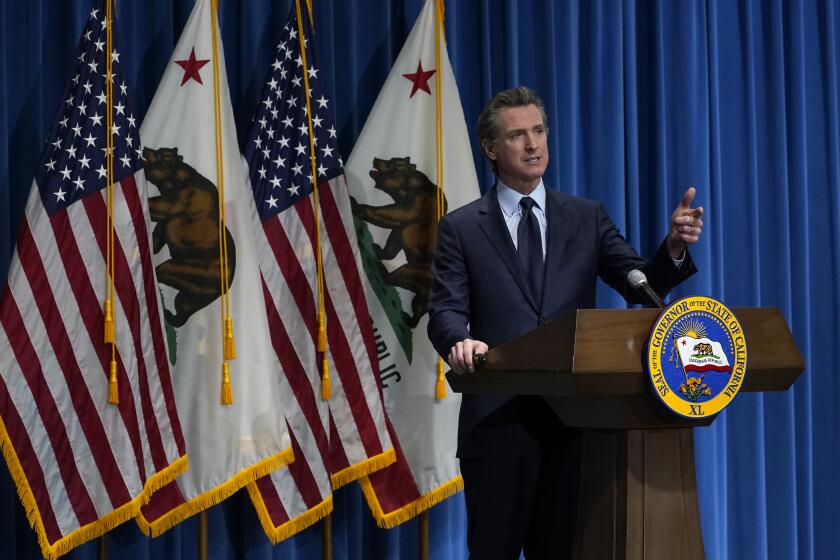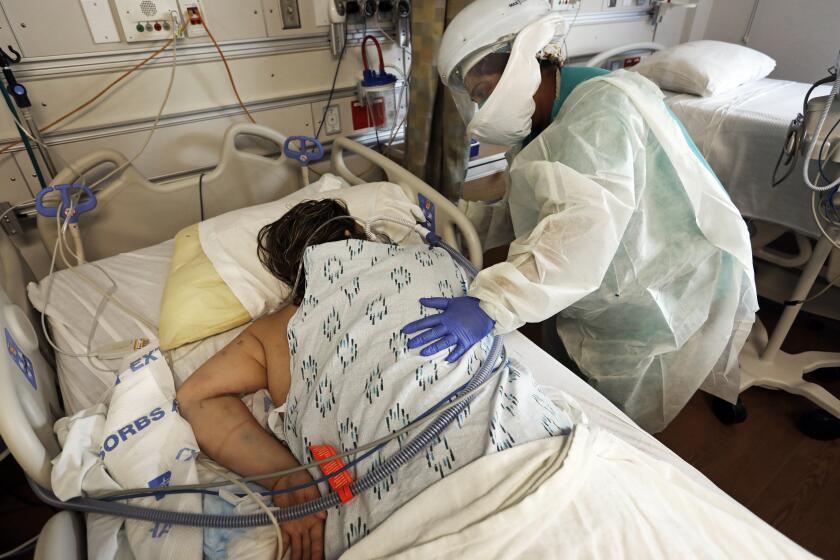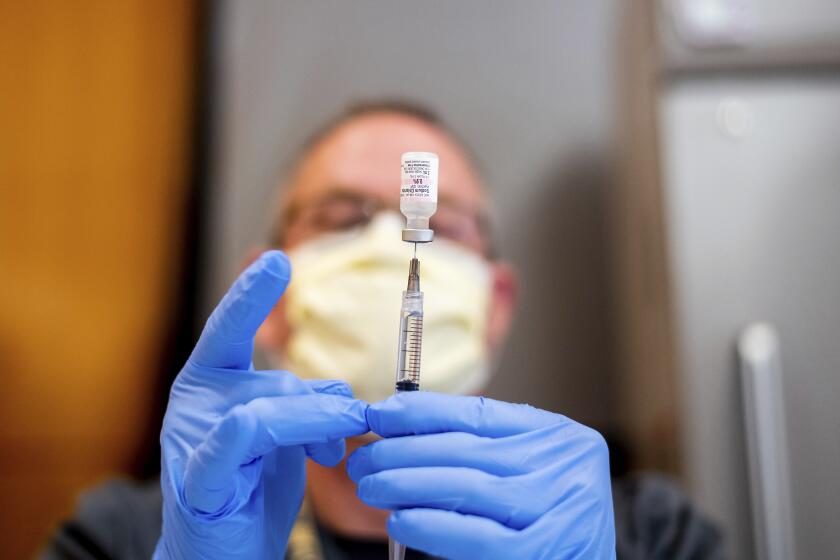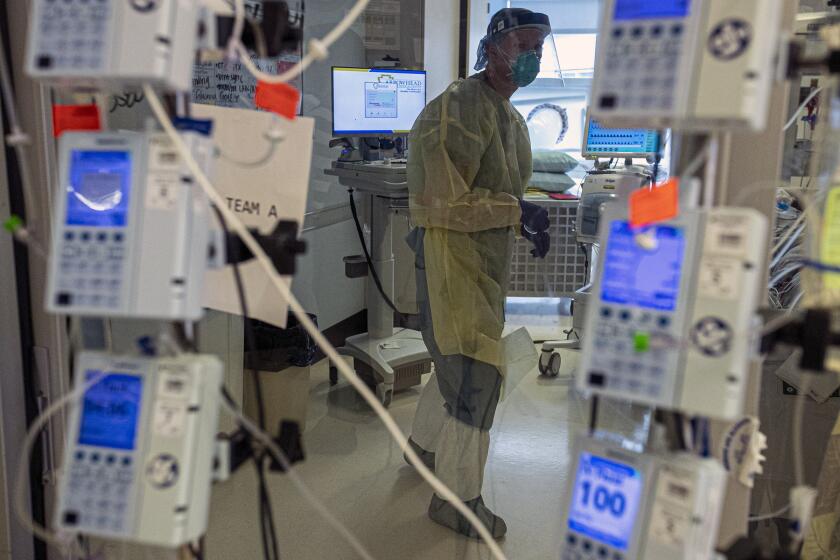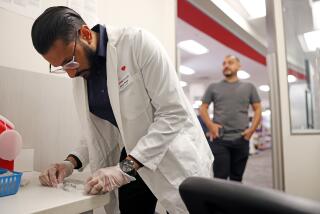New coronavirus variants are an urgent threat. Here’s what you need to know
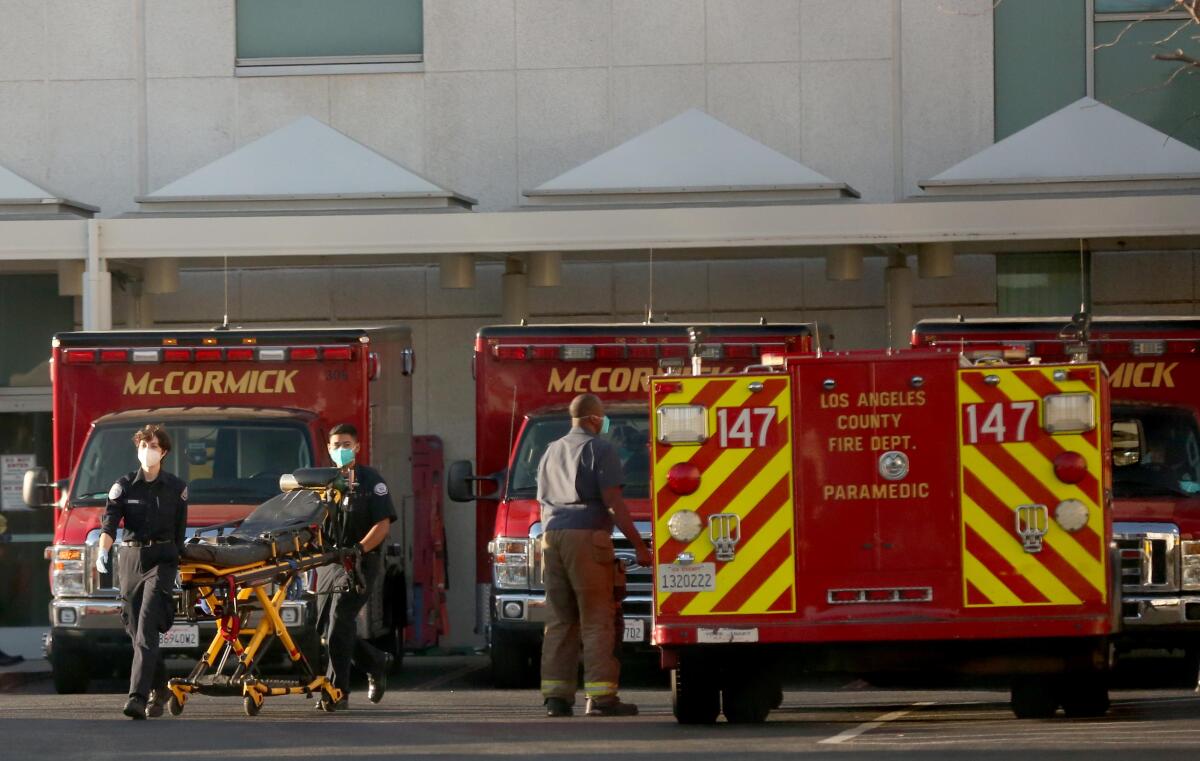
Even as the pandemic crisis eases in California, federal officials and experts Sunday warned that the dangers of rapidly growing new coronavirus strains underscore just how urgent it will be to speed up vaccinations.
San Diego and Florida are home to two hot spots of the same new strain of the virus that has ravaged Britain, Dr. Scott Gottlieb, the former commissioner of the U.S. Food and Drug Administration, told CBS News’ ”Face the Nation” program Sunday. California has the most identified cases of the U.K. strain — 72 — of any state, while Florida has the second highest number, with 50 cases; New York comes in third, with 22 cases.
Dr. Anthony Fauci, President Biden’s chief medical advisor, warned that federal officials “have every reason to believe” British scientists’ new conclusion that the new strain is deadlier than the original virus.
Previously, scientists had thought the U.K. variant — known as B.1.1.7 — was merely more transmissible, but the latest evidence suggests that those who have contracted the virus are also more likely to die from it, Fauci said Sunday on “Face the Nation.” The U.K. variant has been identified in more than 20 states.
“When the British investigators looked more closely at the death rate of a certain age group, they found ... a significant increase,” Fauci said. “We need to assume now that what has been circulating dominantly in the U.K. does have a certain degree of increase in what we call virulence — namely the power of the virus to cause more damage, including death.”
The action by state officials means restaurants and gyms could soon reopen outdoor services. Counties will make the final call, however.
California lifts stay-at-home orders
The worries about the new variants come as Gov. Gavin Newsom on Monday lifted regional stay-at-home orders in California, setting the stage for counties to reopen outdoor dining unless they decide to maintain stricter local health orders.
“We expect we’ll be able to reopen to some degree safely as early as this upcoming week,” Dr. Grant Colfax, the San Francisco director of public health, said in remarks broadcast on KNTV-TV on Sunday night. “We need to continue to wear those masks and socially distance and take the precautions — we’re certainly not out of the woods yet — but certainly things look a lot better here locally than they did even just a few weeks ago.”
The move comes about seven weeks after the stay-at-home order began rolling out across much of California. The policy infuriated some restaurant owners, but health officials have credited it with avoiding an even greater catastrophe in the state’s hospitals — which have stretched healthcare workers thin and threatened the rationed care among patients.
Scientists have largely credited California’s aggressive stay-at-home orders with saving lives. California has the 38th worst cumulative COVID-19 death rate among the 50 states, the District of Columbia and Puerto Rico, with 94 deaths per 100,000 residents.
Nearby Arizona has done far less to order business closures and has refused statewide mask measures while allowing indoor restaurants and bars to remain open. The result is a far worse cumulative death rate: the 10th worst in the nation and nearly double California’s — 175 deaths per 100,000 residents.
As the number of coronavirus infections in California approaches 3 million, health officials said Sunday that a new strain — different from a highly contagious variant first identified in the U.K. — is popping up across the state.
Mounting worry over deadlier new variants
The U.S. Centers for Disease Control and Prevention has warned that the U.K. variant could be the dominant strain in the U.S. by March. Gottlieb expressed particular concern about the emergence in San Diego and Florida, where, he said, it might already be comprising 1% or 2% of new infections.
If that’s the case, “they do face the risk of outbreaks with these new variants because it’s reached a threshold where it may grow quickly enough that our vaccines and our warming weather won’t be enough of a backstop to keep these at bay,” Gottlieb said. “We could certainly face regionalized epidemics because of these new variants.”
An ongoing concern is whether current vaccines will be effective against the variants. There is some suggestion that the two vaccines distributed in the U.S., manufactured by Pfizer and Moderna, seem to be protective against the U.K. strain, although there is a “minor diminution” of how effective they are, Fauci said.
But the most concerning new variant studied worldwide is a strain now prevalent in South Africa, known as B.1.351, Fauci said. The South African strain has not been identified in the U.S., but it is possible that it is here and hasn’t been detected.
Compared with the U.K. strain, the South African variant “looks like it does diminish moreso the efficacy of the vaccine. But we’re still within that cushion level of the vaccines being efficacious against these” variants, Fauci said.
Coronavirus mutations are on the rise. The longer it takes to vaccinate people, the more likely we’ll see a variant that eludes our tests, treatments and vaccines.
Variants may require vaccines to need upgrades
It’s possible that officials will need to upgrade the vaccines if circumstances change, Fauci said.
“What we will do and are doing already is making preparations for the possibility that down the pipe, down the line, we may need to modify and upgrade the vaccines,” Fauci said. “We don’t need to do that right now. The best way to prevent the further evolution of these mutants is to vaccinate as many people as possible with the vaccines that we have currently available to us.”
Gottlieb said it’s not surprising that the U.K. variant may be more deadly.
“It was never fully satisfying that the strain could be more contagious but wouldn’t be more pathogenic — wouldn’t get people more sick,” Gottlieb said. If the U.K. strain does allow the coronavirus to stick more tightly to human cells, you could easily come up with reasons why this variant “could be more infective, more virulent and potentially more dangerous.”
Gottlieb said he suspected that the South African variant, and a closely related new strain identified in Brazil — known as P.1 — are probably in the U.S., even if they haven’t been detected here.
“Given how widespread it is in Brazil right now, and how widespread it is in South Africa, and given all the connections we have to those nations, we have to assume it’s in the United States right now.”
California scientists have discovered a new coronavirus strain that appears to be propagating faster than any other variant in the Golden State.
California’s homegrown new strain under scrutiny
A fourth new strain, believed to be homegrown in California, has also sparked concern among scientists at UC San Francisco and Cedars-Sinai Medical Center in Los Angeles. The new strain, called B.1.426, went from being virtually undetectable to suddenly accounting for one-quarter of analyzed viral samples, and its sudden rise and distinctive mutations have made it a prime suspect in California’s vicious holiday surge.
One of the mutations in California’s homegrown strain, known as L452R, alters the virus’ ability to infiltrate human cells and turn them into virus-making factories. Over multiple generations, even a small improvement in this ability will help a virus propagate more easily, driving up infections, hospitalizations and deaths.
Dr. Vivek Murthy, President Biden’s nominee for surgeon general, said on ABC News’ “This Week” program Sunday that the rise of the new strains is concerning and means that Americans will need to “double down on public health measures, like masking and avoiding indoor gatherings.”
“We’re in a race against these variants. The virus is going to change, and it’s up to us to adapt and to make sure that we’re staying ahead,” Murthy said.
As the number of coronavirus infections in California approaches 3 million, health officials said Sunday that a new strain — different from a highly contagious variant first identified in the U.K. — is popping up across the state.
More than 11,000 COVID-19 deaths since Jan. 1 in California
The latest surge of the pandemic has been by far California’s worst: More than 11,000 COVID-19 deaths have been reported since New Year’s Day, a staggering toll that underscores the worst public health crisis in modern times.
More than 5,000 COVID-19 deaths have been reported in L.A. County since New Year’s Eve. The pace of deaths has been so enormous that hospital morgues have been overflowing and the National Guard has been called in to help transport corpses to the county coroner’s office for temporary storage. In addition, air quality officials have suspended monthly limits on cremations.
In the meantime, evidence is mounting that California is headed out of its worst wave of the pandemic.
California on Sunday was recording an average of 27,000 new coronavirus cases a day over the past week; that’s an improvement from the nearly 45,000 cases a day recorded for the seven-day period that ended Jan. 10.
L.A. County was recording an average of 8,300 new daily coronavirus cases over the last week as of Sunday, a reduction from about 15,100 cases a day tallied for the seven-day period that ended Jan. 13. (It is possible that a reduction in daily coronavirus cases has occurred as a result of declining testing capacity, such as the conversion of Dodger Stadium from a testing site to a vaccination site.)
The rate at which coronavirus tests are coming back positive has also dropped. In the first week of January, 14.3% of coronavirus tests in California were coming back positive, the highest since the early weeks of the pandemic, but last week, the positivity rate was 8.1%.
In L.A. County, the positivity rate hit 22% during the last week of 2020; the most recent data show it is now at 14%.
The number of COVID-19 patients admitted to California’s hospitals still remains extraordinarily high, but it, too, is moving downward.
At the worst point of the summer wave, COVID-19 hospitalizations hit 7,170 in the state, but this month they were more than three times worse, with hospitalizations climbing to 21,936 on Jan. 6. By Saturday, 17,810 were in the hospital; officials say it will take one or two months of declines before hospitals can start to see meaningful relief.
In L.A. County, hospitalizations hit a high of 8,098 on Jan. 5 — more than triple the peak from the summer. By Saturday, the number had fallen to 6,486 — the lowest in a month.
The average daily death toll still remains extraordinarily high, but it has improved. About 500 Californians are still dying a day from COVID-19 on average over a weekly period, including about 200 a day in L.A. County.
At its peak earlier this month, about 534 Californians were dying a day on average over a weekly period, and about 241 L.A. County residents were dying a day.
Times staff writers Taryn Luna, Jaweed Kaleem and Melissa Healy contributed to this report.
More to Read
Sign up for Essential California
The most important California stories and recommendations in your inbox every morning.
You may occasionally receive promotional content from the Los Angeles Times.
